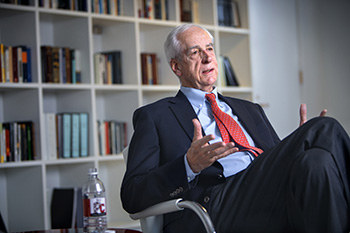From The President
from the president
When I returned to Cornell – for a third, albeit interim role as president – I was determined to have some fun with this job, which entails many responsibilities that require hard work, coping with difficult situations, and lots of travel. Not that those parts of the job are not fulfilling: They are often remarkably rewarding, but I had in mind the sheer intellectual pleasure of following my own natural curiosity.
After pondering the question of how to enable such opportunities, I hit upon a happy answer: invite myself to faculty members' offices to hear about their research and scholarship.

Interim (and Former) President Hunter R. Rawlings III. See larger image
Over the past five months, I have had about a dozen conversations with Cornell faculty members who are at the forefront of their fields, from medieval Chinese literature to physics, from information sciences to economics, from sociology to biomedical engineering. After each one, I have gone home to my wife, Elizabeth, and said the same thing: "You will not believe what I learned today talking with professor X: It is mind-blowing."
Cornell's educational and scholarly missions are lived and breathed by the faculty, and that is just a bit of what this issue of Ezra aims to show – though by any measure, it can barely scratch the surface. Cornell is a phenomenal magnet for talent, intellectual talent that spans the universe of knowledge.
Take David Mimno, assistant professor of information science, whom you will read about (along with a selection of other recently hired star faculty) in this issue. He is combining work in classics and other humanistic disciplines with computers and data science, using mathematical formulas to detect patterns in historical documents and literature. He's finding that this computational approach can find subtle patterns that human beings might otherwise miss, and he hopes to show how this can benefit academic scholarship and help find new approaches to global problems. Of course the fact that he has done pathbreaking work on the text of Thucydides, my own author of choice, did not slip my notice.
Or take Marjolein van der Meulen, professor and director of the Meinig School of Biomedical Engineering. Marjolein has won numerous awards for her research and serves as a senior scientist in the research division of the Hospital for Special Surgery in New York City. She is leading the development of the relatively new biomedical engineering program at Cornell, which links the Ithaca, Weill Cornell Medicine and Cornell Tech campuses, and attracts top students, about half of whom are now women. Marjolein's work spans research and clinical care, teaching and administration, and focuses on the interaction between mechanical stimuli and the skeleton, with particular pertinence to diseases like osteoporosis.
In a world that is in need of discoveries and new solutions, Cornell's uniqueness is embodied by what is happening across our departments and campuses. You can see it in the collaborations that emerge when we have classicists talking to mathematicians, who are talking to engineers and physicists, who are talking to economists and physicians, who are talking to soil and crop scientists. That kind of work across disciplines does not happen enough in the academy. When we do it, the results are amazing.
Look at the wide range of disciplines that address sustainability, also the subject of a major feature in this issue. You'll discover how Cornell has brought faculty members, researchers and students together across the sciences of sustainability to make real impacts on the ground, from improving staple crops amid a warming global climate and finding new business solutions for energy companies, to developing sustainable housing and devising strategies for environmental lawyers.
The free flow of diverse ideas, which happens every day at Cornell between faculty members and students, is fueled by the best and deepest minds. Students are attracted to Cornell and then inspired by our outstanding faculty – individuals who lead in student-centered teaching. Call it the ultimate and best technology transfer: that of knowledge and information from mind to mind.
These past few months I have felt like a kid in a candy store: discovering what's happening across our faculty offices, classrooms, libraries and labs, restarting a liberal education after a five-year absence. It's the best kind of fun I know.
Hunter R. Rawlings III